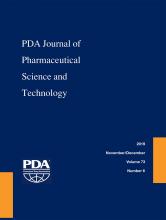Abstract
The only definitive management of snake envenoming is the use of snake antivenom. Endotoxin contamination is a serious threat to the safe use of parenteral drugs. A greater understanding of the nature of limulus amebocyte lysate (LAL) test interference and use of permissible dilutions has minimized enhancement problems. Common interference issues include suboptimal pH, enzyme or protein modification, and nonspecific LAL activation. This study aimed at determining the interference factors associated with validating the antivenom sera preparations to avoid false-positive results when testing snake antivenom serum samples by the LAL method. Phase I (preliminary screening/interference assay) was performed to determine a compatible test dilution, which was then used in Phase II (inhibition-enhancement/validation study). The best approach to resolve interference issues was dilution by 1:80 (maximum valid dilution) plus a specific treatment as heat-activation at 70°C–80°C for 10 min with rehydration of LAL reagent with endotoxin-specific buffer solution.
LAY ABSTRACT: Snake antivenom sera are produced by immunizing horses with repeated nonlethal doses of snake venom. Bacterial endotoxins constitute one of the major problems in the formulation of pharmaceutical products. One such method for detecting endotoxin levels is the bacterial endotoxin test (BET). However, some substances show strong interfering action with the BET that cannot be avoided by simply diluting the sample solution. In this work, the test for interfering factors was performed as two identical series of product dilutions—one spiked with 2λ and one left unspiked. The result of the interference test revealed the noninterfering dilution (NID) of the product, which was used for the actual validation. Our results showed that after treating the samples using different procedures, such as heat activation at 70–80°C for 10 min followed by centrifugation at 2000 rpm for 10 min and dilution of samples in BD100 (biodispersing agent), inhibition and enhancement up to 1:100 maximum valid dilution (MVD) were observed. Finally, to resolve this inhibition/enhancement problem, the activated sample was heated at 70–80°C for 10 min with rehydration of the Endosafe LAL reagent in an endotoxin-specific buffer solution (BG120) to block β-d-glucans and limulus amebocyte lysate (LAL) reactive material (LAL-RM).
- Polyvalent horse snake antivenom
- Endotoxin
- LAL
- Validation study
- Maximum valid dilution
- Interference factors
- © PDA, Inc. 2019
PDA members receive access to all articles published in the current year and previous volume year. Institutional subscribers received access to all content. Log in below to receive access to this article if you are either of these.
If you are neither or you are a PDA member trying to access an article outside of your membership license, then you must purchase access to this article (below). If you do not have a username or password for JPST, you will be required to create an account prior to purchasing.
Full issue PDFs are for PDA members only.
Note to pda.org users
The PDA and PDA bookstore websites (www.pda.org and www.pda.org/bookstore) are separate websites from the PDA JPST website. When you first join PDA, your initial UserID and Password are sent to HighWirePress to create your PDA JPST account. Subsequent UserrID and Password changes required at the PDA websites will not pass on to PDA JPST and vice versa. If you forget your PDA JPST UserID and/or Password, you can request help to retrieve UserID and reset Password below.






